Abstract
This manuscript presents a comprehensive literature review with the aim to provide readers a reference document with up-to-date information on the field of methanol use as a chemical marker. It has been a little more than a decade since methanol was first introduced as a marker for assessing solid insulation condition in power transformers. It all started when methanol was identified in the laboratory during thermal ageing tests carried out with oil-immersed insulating papers and was subsequently also identified in transformer field samples. The first publication on the subject was released in 2007 by our research group. This review covers the methanol fundamentals such as the analytical methods for its determination in transformer oil, which is generally performed by headspace gas chromatography with mass spectrometry or flame ionization as a detector. Current standardization efforts for its determination include ASTM working group 30948 and IEC TC10. Kinetic studies have confirmed the relationship between methanol generation, the number of broken 1,4-β-glycosidic bonds of cellulose and changes in mechanical properties. Laboratory tests have confirmed its stability at different accelerated ageing temperatures. Several utilities have identified methanol during field measurements, case studies on power and some distribution transformers are presented, as well as transformer postmortem investigations. These field-testing results demonstrate its utility in monitoring cellulosic insulation degradation. Recently, a model of methanol interpretation has become available that allows for evaluation of the average degree of polymerization of core type transformer cellulose winding. Methanol has a role as an indicator of cellulosic solid insulation ageing in transformer mineral oil, and it is expected that in the future it will be in routine use by utilities.
1. Introduction
Multiple factors, such as electrical, mechanical and thermal stresses, influence the lifespan of transformers. These factors interact with the components of the transformer insulation system, which is typically composed of cellulosic insulation materials in the form of paper, pressboard and transformer boards, as well as mineral oil. The combined action of temperature, oxygen and moisture over the transformer’s lifetime causes the oil and solid insulation material to degrade and to generate gaseous decomposition products dissolved in the mineral oil. In time, the oil can be reclaimed or changed. However, the cellulosic insulation cannot be replaced or sampled once the transformer is in service. Its degradation causes a loss of the insulation’s mechanical properties and may ultimately result in loss of the equipment due to a short circuit between conductors. Therefore, it is essential to monitor cellulose degradation in order to ensure proper transformer operations.
The analysis of chemical markers is a simple, economical way to indirectly characterize insulating paper. By chemical markers, we are referring to oil-soluble cellulose depolymerization by-products. Mineral oil can easily be sampled from a unit under operation, and standard practices for sampling electrical insulating liquids are available. On the other hand, the direct method of measuring degree of cellulose polymerization is not applicable to in-service transformers because, in order to access the paper, the unit must be shut down, the tank opened and the oil level lowered.
Just over a decade following the first publication on the subject [1], the use of methanol for the determination of cellulose ageing continues to grow. Indeed, many publications on the subject in scientific journals [1,2,3,4,5,6], at conferences [7,8,9,10,11,12,13,14] and in an international working group [15] have revealed this small molecule’s potential to track the state of cellulose degradation. Methanol and ethanol are third-generation chemical markers of transformer diagnostics. The first generation, in use since the 1980s, consists of the measurement of carbon oxides and carbon dioxide present in the transformer oil. However, they can be generated not only from paper degradation but from long-term oxidation of the oil in open-breathing units during normal operation or in nitrogen-conservator units facing air entry. The second generation, introduced in the 1990s, involves the measurement of a family of furanic compounds such as 5-hydroxymethyl-2-furaldehyde, furfuryl alcohol, 2-furaldehyde also known as 2-furfural, 2-acetyl furan, and 5-methyl-2-furaldehyde present in oil. From this family, the determination of 2-furaldehyde (2-FAL) is a routine test in transformer monitoring. However, when thermally upgraded paper is used in a transformer, 2-FAL’s presence is minimal compared to standard Kraft insulated paper transformers for an equivalent degree of polymerization.
This review outlines the progress in the use of methanol as a chemical marker in transformer oil insulation. It presents an overview of accelerated ageing studies and kinetic studies of methanol formation. The presence of methanol has been found to be related to changes in the cellulose’s mechanical properties. Its stability in oil and different methods for quantifying its presence are presented as well. Nowadays, many laboratories around the world track methanol during routine transformer oil analysis. Meanwhile, Hydro-Québec, which pioneered this approach, started using this measurement in routine laboratory work in 2010. Today, the analysis of this molecule dissolved in oil is about to be normalized by international organizations [16,17].
2. Methanol Fundamentals
2.1. Methanol Determination
Since the first method for the analysis of methanol in transformer oil became available in 2007 [1], a handful of publications have presented analytical methods for its determination [4,9,18,19,20,21]. The characteristics of these methods are presented in Table 1. The availability of sensitive methodologies (ng/g) for alcohol analysis in transformer oil has contributed to their use as cellulose degradation indicators.

Table 1.
Characteristics of the available methodologies for the determination of alcohols in transformer oil.
All of these methods are based on the principle of static headspace gas chromatography, as initially reported by Jalbert et al. [1]. Headspace (HS) is essentially an equilibration technique in which volatiles can be separated from a complex sample matrix in the gas phase. The benefits of using automated HS for sample introduction include the minimization of injector and column contamination and less analyte loss since there is less sample manipulation [19]. The oil sample (7–13 mL) is heated at temperatures between 85 and 100 °C for about 40 min to allow the volatile oil-dissolved species (e.g., methanol) to reach equilibrium in the gas phase. Then, the vapor is transferred by the carrier gas into the gas chromatography (GC) column for separation. Molavi et al. [20] present an HS method where gas samples are manually injected into the GC. A fused silica capillary column of mid-polarity phase (6% cyanopropylphenyl and 94% dimethylpolysiloxane) for separation of volatile compounds has frequently been used for this application [18,19,21]. The first reported method [1] required the use of liquid nitrogen to cool the GC column (T < 20 °C) in order to avoid chemical interference, present in the oil matrix, with methanol. The newly available methods [4,8,18,19,21] do not require cryogenic focusing and the separation is typically done by temperature programming starting at 40 °C. The GC separation running time varies between 20 and 55 min depending on the method parameters.
For component identification, two types of detectors have been coupled with gas chromatography: flame ionization detection (FID) [18] and mass spectrometry (MS) [4,8,18,19,20,21]. While FID is the most widely used detector for GC, MS is considered the most powerful [22]. The initial separation method (HS-GC) is similar for the two detectors. In addition, MS allows masses to be scanned repeatedly during the chromatogram experiment. Therefore, in addition to obtaining a chromatogram that contains information about the sum of all ion abundances, known as a total-ion chromatogram, it is possible to display the mass spectrum at a particular time during the chromatogram. In addition, a single mass-to-charge (m/z) value can be selected and monitored through the entire GC run, a technique known as selected-ion-monitoring (SIM) [22]. A m/z = 31 (CH2OH) is associated with methanol and ethanol fragmentation.
An ethanol isotopomer, ethanol-d6, with the structure CD3CD2OD, has been the internal standard of choice for the alcohol methodology with MS detection [8,18,19,21]. Jalbert et al. [19] proposed the use of ethanol-d6 to compensate for random instrumental and method fluctuations that could affect quantification. The five deuterium atoms bonded to the carbons are not solvent exchangeable. However, the deuterium bonded to the oxygen is subject to exchange. It has been experimentally observed that, once ethanol-d6 is added to oil, the deuterium on the oxygen is exchanged for hydrogen from the oil matrix. Therefore, m/z = 33 (CD2OH) is associated with ethanol-d6 fragmentation in a mineral oil matrix instead of the expected m/z = 34 (CD2OD) for its pure form [19]. It is worth mentioning that the fragment of m/z = 33 (CD2OH) also corresponds to the fragmentation of the molecule ethanol-d5, CD3CD2OH, which indicates that this molecule is also suitable as an internal standard. Nevertheless, the higher cost of ethanol-d5, which costs about twice as much as ethanol-d6, favored the use of d6 as the internal standard for alcohol determination in oil. Deuterated ethanol was chosen because it has not been identified in ageing experiments and it resembles the analytes of interest. The selected chromatographic conditions allowed adequate separation from the analytes, methanol and ethanol [19]. In addition, this internal standard has been found useful to compensate for matrix effects observed in oxidized, high-acidity mineral oils and even ester-based oils [23]. A prepared ethanol-d6 solution is added in a constant amount to all samples, blanks and calibration standards for quantitative analysis. Another internal standard, 2-propanol, has been proposed in the literature [20]. Nevertheless, the proposed method was not validated to ageing experiments or field samples to confirm that 2-propanol is not generated during mineral oil ageing.
The analytical performance of the available methods for methanol detection is presented in Table 1. The method sensitivity, expressed as the limit of detection (LOD), is approximately 1–144 ng/g. Sensitive LOD are critical for the identification of methanol in mineral oil. The majority of methods reported in Table 1 have been validated with oil samples collected from in-service electrical equipment. All methods have an adequate linear dynamic range that covers the expected alcohol concentrations in field samples. For precision and accuracy, the values in parentheses in Table 1 correspond to the sample concentration and the number of replicates, n. Precision expressed in terms of relative standard deviation (%RSD) is adequate (2–14%) for standards of low and high concentration. Accuracy expressed in terms of relative error (%RE), indicates that the calibration procedure for these methods is accurate (%RE < 10%). Moreover, the accuracy reported by Bruzzoniti et al. [18] was obtained through a round robin test (CIGRE JWG A2/D1.46) involving seven international laboratories.
Ever since methanol and ethanol were identified as degradation markers [1], there has been a need for a simple, robust, sensitive standard procedure for their determination and straightforward method translation. Two technical committees, CIGRE A2D1.46 and IEC TC10, have performed round robin tests with the participation of international laboratories.
2.2. Laboratory Ageing and Methanol Generation
The limitations on the use of 2-FAL, particularly when thermally upgraded Kraft (TUK) paper was used in power transformers, motivated the search for a more suitable chemical marker, independent of the type of paper. TUK paper is used in a high percentage of modern transformers. The first publication in this field appeared in 2007 in the journal Cellulose [1]. In this paper, for the first time, the authors revealed a direct link between methanol formation and the scission of 1,4-β-glycosidic bonds. From laboratory ageing experiments, they revealed a linear relationship between these two parameters regardless of the type of paper: ordinary Kraft (Clupak HD75) or TUK (Manning 220) paper. In Figure 1, the following curves were obtained from accelerated ageing of paper using sealed glass ampoules over a period of 14,000 h. The graphs in the left section in the figure correspond to the generation of methanol. These two graphs reveal the first part, which is mainly due to the depolymerization of the cellulose amorphous phase, and the second part, which has a less pronounced slope due to the depolymerization of the more stable crystalline phase. It is interesting to note that when methanol appears in the case of the TUK papers, for the same level of deterioration, its generation is higher than what is observed for standard Kraft papers. Moreover, the moisture levels seem not to influence methanol generation for an equivalent level of degradation. These data were compared with 2-FAL generation for both types of paper. On the right side of Figure 1, the generation of 2-FAL in standard Kraft paper appears when the degree of polymerization (DPv) is around 500 with exponential growth and is practically not observed when TUK paper is used. The term, NS, corresponds to the cellulose scission number calculated as DPv(0)/DPv(t)—1. DPv(0) and DPv(t) correspond to the degree of polymerization at an initial time (t = 0) and at a given time.
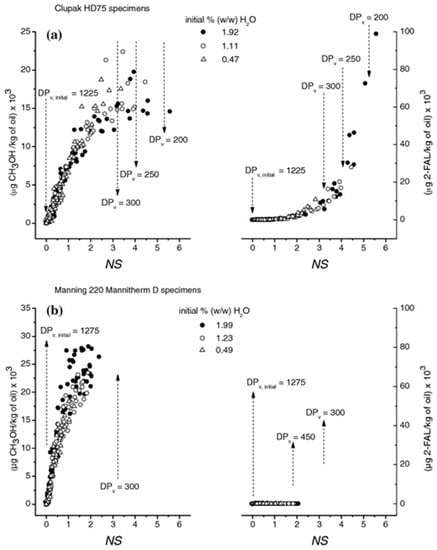
Figure 1.
Comparison of the generation of methanol (CH3OH) and 2-FAL with cellulose scission number (NS): (a) standard Kraft paper, (b) TUK paper, from [1].
In 2011, Schaut et al. [24] presented laboratory data showing the validity of methanol as an early paper degradation marker. The authors presented ageing data and stability studies in vials with different septum types. Despite overpressure buildup in some vials, they were able to obtain reliable data on methanol behavior. Other data obtained in glass ampoules at different temperatures and moisture contents reveal the sensitivity of methanol over 2-FAL for standard Kraft paper containing low levels of moisture. More recently, another lab performing ageing in bottles with caps reached the same conclusion: that methanol is an early-stage cellulose degradation marker [5].
Another experimental technique to accelerate the degradation of transformer cellulose insulation consists of using an excimer laser coupled with an infrared camera to monitor the temperature reached by the samples [25,26]. Using this technique, the authors broke the chemical bonds of the cellulose and were able to measure the alcohol generation. Although this technique seems an unusual way of characterizing thermal ageing, the authors found that oxygen and moisture have a detrimental effect on ageing. These results suggest that the laser-induced cellulose degradation occurs through direct photolysis (i.e., direct breakage of C-C, C-O and C-H bonds), leading to radical formation, which, in turn, is believed to induce the acid hydrolysis degradation mechanism, a moisture-dependent process. Moreover, as shown in Figure 2, scanning electron microscopy (SEM) mapping shows the deterioration of the fibers using this technique.
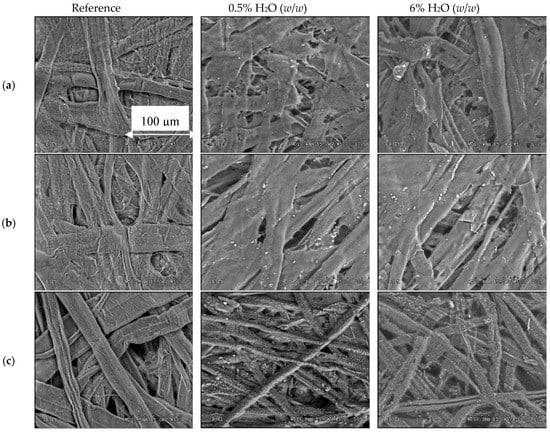
Figure 2.
SEM analysis samples: (a) Clupak, (b) Munksjö Thermo70 and (c) Mannitherm D irradiated at laser energy of 310 mJ for 3 min [26].
2.3. Kinetics of Cellulose Depolymerization and Methanol Formation
For cellulose materials used as solid transformer insulation, kinetic studies provide information about the ageing mechanism and the possibility of using estimated rate constants for lifetime prediction. As shown in Figure 3, a relationship exists between methanol formation and the breaking of 1,4-β-glycosidic bonds in cellulose [1]. Therefore, studies have been performed to confirm the kinetic correspondence between these two processes [27,28,29,30].
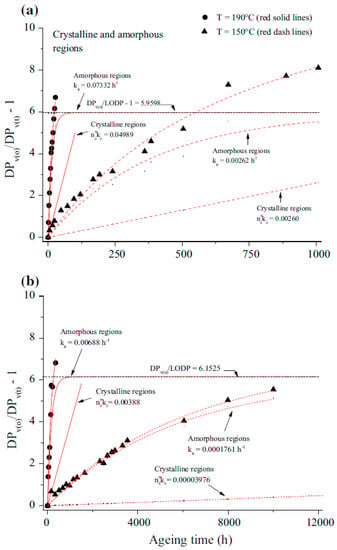
Figure 3.
Two-branch patterns of amorphous and crystalline regions obtained during accelerated ageing at 150 and 190 °C: (a) standard Kraft paper (Clupak-HD75), (b) thermally upgraded paper (Densiflex-22HCC, 1.8% N) [29].
The kinetics of cellulose degradation has been extensively studied in the last 80 years, and ageing models have changed substantially. The first kinetic depolymerization model was introduced by Ekenstam [31]; based on his early model, a pseudo-zero-order Ekenstam’s approximation, Equation 1, has been used by many researchers to track the degradation of cellulose:
DPv(0) and DPv(t) correspond to the degree of polymerization at an initial time (t = 0) and at a given time that approaches the LODP (leveling-off degree of polymerization); k0 is the rate constant and t, the time. Calvini [32] provides a thoughtful explanation of the meaning of this equation. The left-hand side (1/DPv(t) − 1/DPv(0)) is the number of broken bonds per anhydroglucose unit and should not be confused with the “fraction” of broken bonds. Calvini [32] proposed to multiply the right-hand side by a concentration-dependent parameter to guarantee internal coherence. This correction factor n0 = 617(1/LODP − 1/DPv(0)) allows one to estimate the ageing time necessary to perform kinetic analysis by measuring the value of LODP and the initial degradation of the Ekenstam domain. In the last 20 years, three further derivations of the Ekenstam equation have been developed [33]: (i) the Emsley model (1997) [34], (ii) the Ding and Wang model (2008) [35], and (iii) the Calvini model (2008) [36]. The Emsley equation reads
in which ka is the initial degradation rate constant, and k2, the rate at which ka decreases. Emsley et al. [34] concluded that this model provided greater accuracy in the prediction of the time required to reach low DPv values. This model was successfully applied by other authors to the study of the depolymerization of standard wood Kraft [27] and TUK insulating papers [28] under accelerated ageing conditions (T between 60 and 130 °C). For methanol (CH3OH) generation during the opening of the glycosidic bonds, the authors proposed the following equation, by analogy with Equation (2).
The kinetic results revealed that the production of chain-end groups and the formation of methanol require about the same activation energy (Ea), with a similar frequency factor (lnAa). This confirms that both reactions (depolymerization and methanol formation) are governed by the same degradation pattern regardless of the type of insulating material in a transformer. The authors also observed that the severity of the ageing conditions has no effect on Ea while Aa is affected by the ageing medium. It was also noticeable that the length of the ageing test was not sufficient to allow an accurate determination of the parameters at lower temperatures (<100 °C). A significant error was observed when modeling the kinetic data for cases where the LODP was not reached, a situation that was predominant during the ageing of TUK papers. For example, over three years of ageing at 70 °C, there were no significant changes in DPv.
In 2008, Ding and Wang [35] proposed a single first-order evolution equation in terms of the percentage DPv loss for the cellulose degradation:
ωDP is the accumulated DPv loss of cellulose. Different values of the degradation variable correspond to different states of the cellulose: (a) ωDP = 0 corresponds to the undegraded state; (b) ωDP = 1 corresponds to the fully degraded state (i.e., failure); and (c) 0 < ωDP < 1 corresponds to the degraded state. corresponds to the capacity of the DPv degradation reservoir as defined by the constraint condition ωDP (t = tf) = 1, where tf is the time to failure of the specimen under specific experimental conditions. Ding and Wang validated this equation by fitting data from several experiments under different experimental conditions. In their experiments, they performed accelerated ageing studies of Kraft and TUK papers in mineral oil at different temperatures and various conditions including dry, moist and sealed vessel ageing.
However, Calvini [33] emphasizes that the equation of a scientific model should satisfy at least three constraints:
- internal coherence, tested through dimensional analysis;
- boundary conditions, tested through their limits at t = 0 and t = ∞;
- physical meaning.
Calvini analyzed the Ding and Wang Equation (4) [33,37] based on the above constraints; he disagreed with their kinetic approach. For the Emsley Equation (2), Calvini proposed an upgrade to the original version [33], which met only the first two of the three constraints.
The modified Emsley Equation (5) satisfies all three constraints. On the right-hand side of Equation (5), ka is the initial rate constant of the degradation; k2, the rate constant at which ka decreases; and t, the elapsed time. The internal coherence constraint allows the use of scissions per monomer (1/DPv(t) − 1/DPv(0)) or scissions per chain (DPv(0)/DPv(t) − 1), without changing the values of the constants ka and k2. The constant parameter (DPv(0)/LODP − 1) does not influence the activation energy estimated by the Arrhenius law. In 2008, Calvini et al. [36] proposed a model that applies first-order kinetic laws to weak, amorphous and crystalline regions of cellulose.
In the Calvini Equation (6), the left-hand side keeps the same meaning as in Equation (5), scissions per chain. On the right-hand side, , and correspond to the initial number of weak bonds, amorphous region bonds, and crystalline region bonds, respectively. The constants , and are the corresponding reaction rate constants, and t is the elapsed time. Equation (6) satisfies all the constraints.
To go further in the assessment of methanol for the monitoring of cellulosic condition in transformers, Jalbert et al. [29] extended two previous studies (standard Kraft paper [27] and TUK paper [28]) to accelerate the opening of the bonds at higher temperatures (T between 130 and 210 °C). The goal of their study was to extend the degradation beyond the LODP and confirm if the same reaction pattern was present over a range of 60–210 °C, which would then allow the estimation of the rate constants of lower temperatures by extrapolation of the high-temperature values. They tested some of the mathematical models listed above to track the experimental data measured under accelerated conditions for depolymerization and methanol formation. Jalbert et al. [29] explored the applicability of Equation (6) to the data obtained from the accelerated ageing studies of cellulosic insulation by looking first at the contribution of the weak links. As Calvini et al. [38] pointed out, if weak links really exist, they should not resist a preliminary alkaline/acidic purification treatment. Therefore, the number of weak links (preoxidized groups in the β-D-glucopyranosyl units of the cellulosic material) before ageing was estimated. This was achieved by comparing the specimens’ DPv before and after the reduction of these groups after treatment with a solution of TBAB (tert-butylamine borane) in phosphate buffer (pH 7) for 24 h. The results of these experiments [29] show that the contributions of weak bonds on standard Kraft and TUK paper were negligible. Calvini et al. [36] had determined that if the number of weak links can be neglected and ka >> kc, the kinetics of degradation of the amorphous region is affected by a deceleration corresponding to the LODP; therefore, . If it is also considered that the opening of the bonds in the crystalline region is at its beginning (linear function from Ekenstam’s approximation [36]), Equation (6) changes as follows [28,29]:
More recently, Calvini [33,39] showed that might be influenced by a limitation of viscometric analysis during DPv determination. This limitation consists of the alkaline degradation of the viscometer of oxidized spots (potentially degraded anhydroglucose units). Therefore, Equation (7) can be updated to
where is the linearized contribution of other slower reactions that affect the kinetics of the amorphous regions. The term J gathers all the constant parameters of the unknown mechanisms and kinetics and is the rate constant.
The applicability of the above equations to the accelerated ageing of cellulosic insulation was explored by Jalbert et al. [29], who investigated the effect of the potential viscometric limitation mentioned by Calvini ( versus ). Changes in weight and degree of polymerization of samples from accelerated ageing at 190 °C and from a 40-year-old decommissioned transformer were measured before and after inducing alkaline β-alkoxy fragmentation (treatment with 0.01 M NaOH). Even though the authors induced the accelerated ageing at DPv values below the papers’ LODP, there were no differences between the weight and measured DPv after the NaOH treatment; the same results were also obtained for the transformer paper samples. Thus, the effect of the oxidation of the OH sites along the cellulosic chains and the formation of acid-stable but alkali-labile cross-links that could affect the viscometric determinations of DPv were considered negligible. Consequently, Jalbert et al. [29] applied Equation (7) instead of Equation (8) to their results. An example is shown in Figure 3, which presents the two-branch patterns of the amorphous and crystalline regions. The authors concluded that solid insulation could be depolymerized to a level beyond the LODP by a random opening of the glycosidic bonds in both the amorphous and crystalline regions of the material. The main mechanism of degradation corresponds to acid hydrolysis, especially for the amorphous region. In the crystalline region, the predominant mechanism is a pyrolysis-like mechanism that lowers the DPv below the LODP.
To track methanol generation, Jalbert et al. could not apply the three-segment model due to a fluctuation of methanol concentrations observed at longer ageing periods when the insulation has already reached its end of life (DPv < 200). Therefore, the original Emsley version, Equation (3) was used. As observed in previous studies [27,28], the kinetic results revealed that the production of chain-end groups and the formation of methanol require about the same activation energy (Ea), with a similar frequency factor (lnAa). Table 2 shows the Arrhenius parameters obtained in that study [29].

Table 2.
Arrhenius parameters of depolymerization and methanol formation for the ageing of standard Kraft paper and thermally upgraded insulating paper (130–210 °C) [29].
The Arrhenius relationship applied to the data for standard Kraft and TUK paper shows a very good linearity with 1/T for the full range of temperatures 60–210 °C. The Ea and lnAa were in agreement with the values shown in Table 2. The authors emphasized that, to achieve this correlation, it is important to perform ageing tests at least until LODP to avoid misleading interpretations of kinetic data. These results confirm that the degradation reaction is governed by a unique mode of degradation, which opens up the possibility of using accelerated ageing tests at higher temperatures to estimate insulation conditions at transformer operating temperatures.
Jalbert et al. [29] also observed that the nitrogenous substances present in TUK paper significantly modified the reaction mechanism by limiting the action of water and hydronium ions coming from the oil. Figure 4 shows the degradation scheme for standard Kraft and TUK paper in mineral oil.
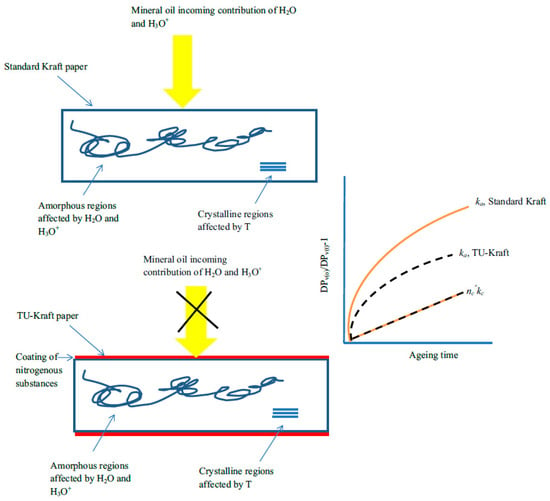
Figure 4.
Hypothetical degradation aspects of a standard Kraft and a TUK paper showing the constants for the amorphous and crystalline regions of papers with the same crystallinity, from [29].
2.4. Paper’s Mechanical Properties and Methanol
Paper is not a uniform material; it is essentially a mat of cellulose fibers [40]. During the manufacturing process, a high percentage of fibers are aligned with the machine direction. This process produces an anisotropic material. As an example, the mechanical strength of paper is higher in the machine direction than in the cross-machine direction [41]. Currently, there is no unanimously accepted parameter to establish the end of life of paper based on its degree of depolymerization or remaining mechanical strength. In some cases, a DPv of 200 [42,43] or even 100 has been mentioned [44], while in other studies 50% [42,45] or 20% [46] of the original mechanical strength is considered.
Several analytical models [47,48,49] are used to describe paper’s mechanical strength and elongation. These models assume a homogeneous (perfectly uniform) fiber network of cellulose, whose strength is based on the endurance of the individual fibers. Other models assume a perfect composite material reinforced with fibers [47]. However, paper strength results based on these models present a certain divergence from the laboratory results, due mainly to the assumption that the paper has no anomalies or defects. In addition to the analytical models, other models based on numerical modeling [41] have been developed to describe the mechanical strength of paper.
The structural hierarchy of paper is a theory developed by Kortschot [50]. It explains the complex structures and connections that compose paper as a material. The mechanical properties of paper are based on the strengths of the different structural levels. These levels are interconnected, and diverse parameters define strength at different levels. At the molecular level, strength depends on the structural integrity of cellulose chains (cellulose’s molecular weight and degree of polymerization). At the microstructural level, the chains of cellulose form elementary fibrils, which subsequently form microfibrils, fibrils and fibers (hemicellulose and lignin). The individual strength of the different cellulose fibrils and fibers, in addition to the strength of interfiber bonds, determines the strength of paper at this level [51,52]. At the macrostructural level, mechanical strength is based on the uniformity of fiber orientation, distribution of mass, presence of impurities and manufacturing defects such as local changes in the grammage. Local defects in the paper produce zones called “mesostructures” where the paper presents lower-than-average mechanical strength. Mesostructures are where the paper is most likely to mechanically fail [49,50]. Thus, the loss of paper’s mechanical properties due to ageing starts at the molecular level with cellulose depolymerization and with subsequent reactions that produce a loss of strength at the different structural levels. Paper’s mechanical strength may also be affected by the hornification that occurs during drying. However, this mechanism may also be produced at the same time as the thermally accelerated ageing of paper [53]. Hornification results in the formation of hydrogen bonds inside the cellulose fibers [54]. This phenomenon decreases the fibers’ flexibility and increases their brittleness, with the consequent reduction in mechanical strength [53,54].
Different techniques are used to determine the changes in paper’s mechanical performance during ageing, such as tensile strength, flexural strength, folding endurance strength, edge tearing resistance and bursting strength [55,56,57,58,59]. Tensile testing is the technique used in several studies to track the loss of mechanical strength during paper ageing [30,41,45,46,55,57,59,60,61,62,63,64,65,66,67]. It has been shown that the condition of paper, when chain scission is involved, can be monitored using tensile strength as a reference [41]. However, the negative aspects of tensile testing are its sensitivity to the water content in paper and the measurement temperature [55,57] and its high standard deviation of the results.
Tensile strength is also used as a reference because there are internal radial and axial forces in the interior of a power transformer [68], such as axial Lorentz magnetic force. This force produces a contraction and stretching (vibration) of the coils, with the consequent elongation of the paper that wraps the conductors [41]. In addition, the electrostatic force (friction) created by oil circulation also affects the strength of the external paper layers [69]. For this reason, some papers are produced by the creping process (crepe paper) to improve their tensile elongation properties. In the pulp and paper industry, the tensile strength of paper is measured using the tensile index (Tidx). This index is defined as the breaking force per width and divided by the grammage of paper [70]. Grammage is defined as the mass per unit area of paper, expressed as grams per square meter [56].
Studies of thermally accelerated ageing of paper impregnated with mineral oil revealed a quasilinear, temperature-independent correlation between the mechanical strength of paper (using the zero and wide span modes) and the cellulose’s degree of polymerization [30,41,45,46,52,57,61,62,71], as seen in Figure 5. In the first part of the master curve, up to around DPv = 700, for different temperatures and types of paper, the mechanical strength of paper does not decrease with the decline in degree of polymerization [41]. This is because, at that level of ageing, paper’s mechanical strength depends on the degree of polymerization but also on other parameters such as individual fiber strength, extent of chain entanglements, degree of crystallinity and interfiber bond strength [30,41]. In this first part of the curve, depolymerization is also faster. This is due to easier access to the amorphous regions of cellulose, which are less well organized, to break glycosidic bonds. In the second part of the master curve, a linear correlation between the two parameters is clear. Both parameters decrease at the molecular and macrostructural levels. The mechanical strength of paper is driven by the rate of depolymerization of cellulose and the molecular weight of cellulose [41]. The increase in ageing temperature acts as a catalyst to accelerate ageing. However, the same path is followed by the paper independent of temperature. In addition, the accumulation of points at the end of the curve marks the end of the paper’s service life at around a DPv of 150 or 10–20% of the initial mechanical strength [30]. Based on experimental results and this linear correlation, some equations were developed to correlate the two parameters [46,72]. Nevertheless, it is practically impossible to measure both parameters for power transformers in service.
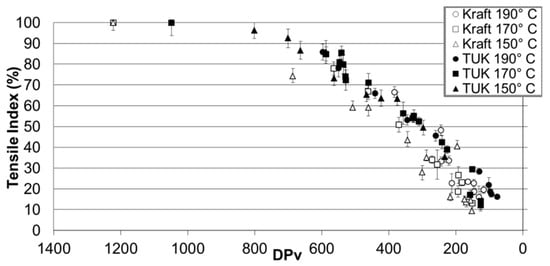
Figure 5.
Degree of polymerization versus tensile index of paper samples, from [30].
Several research studies have investigated the relationship between chemical markers and degree of polymerization. Some studies found correlations between the concentration of carbon oxides and 2-FAL in oil with DPv [40,66,73,74,75]. These correlations present advantages, disadvantages and, in some cases, lack sensitivity in TUK papers [74], as shown in Figure 1. As described in Section 2 of this manuscript, Jalbert et al. [1] showed that there is a quasilinear correlation between methanol generation and DPv.
Based on the previous two quasilinear correlations—the first between mechanical properties and degree of polymerization and the second between methanol and degree of polymerization—a third quasilinear correlation was deduced between the generation of methanol and the change in mechanical properties during paper ageing for a wide range of temperatures [30,61,62,76] (see Figure 6). Again, two linear tendencies, one for Kraft and one for TUK paper, are generated between the two parameters due to the partition phenomenon (discussed in detail in Section 5). Based on this correlation, the concentration of methanol in mineral oils can be used to estimate the level of degradation and remaining percentage of mechanical properties in Kraft and TUK papers. This correlation also connects two different structural levels of paper: the generation of methanol related to the depolymerization of cellulose chains at the molecular level and the mechanical strength of paper at the macrostructural level. The influence of temperature on this correlation is also direct. An increase in temperature accelerates the ageing of cellulose, but again cellulosic paper follows a single path during ageing. A similar correlation and similar behavior are expected at lower temperatures such as for in-service transformers. Thus, this correlation creates the possibility of developing tools to assess the state of transformers; however, it is important to emphasize that a model based on laboratory data needs to be validated with real transformer data such as during postmortem analysis.
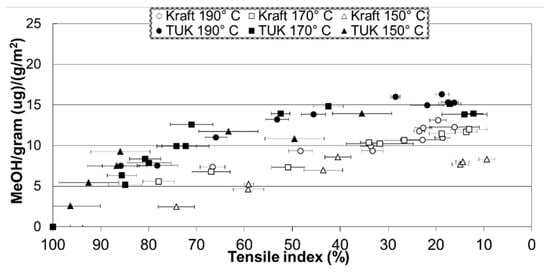
Figure 6.
Tensile index of paper samples versus concentration of methanol normalized by paper grammage, from [30].
The kinetics of the changes in mechanical strength has been studied using models that depend on cellulose depolymerization. From these kinetic studies, Arroyo et al. [30], who used Equation (7) of this manuscript as their starting point, proposed a modified Calvini equation to track the changes in paper’s tensile strength during ageing:
= (DPvo/LODP–1), and are the initial quantity of glycosidic bonds in the amorphous and crystalline regions, respectively, and ka and kc are the reaction rate constants for the amorphous and crystalline regions.
Equation (9) was proposed based on the intrinsic and physical relationships among the molecular weight of cellulose, the formation of methanol and tensile strength. In all cases, a good regression was obtained when the kinetic models were applied using the results of accelerated ageing experiments in laboratory conditions. Using the kinetic models for the loss of mechanical strength and the Arrhenius equation, the models showed a linear dependence between the ageing temperature, even at high temperatures (190 °C), and the reaction rate constant of the change in tensile strength (for both Kraft and TUK paper) [30]. The activation energy and frequency factor for each of three studied reactions—depolymerization, methanol formation, and loss of tensile strength—have similar orders of magnitude. The results support the intrinsic physical relationship between these parameters and the decision to use the same kinetics equation to model all three [30].
As discussed in Section 2.2 and Section 2.3, acid hydrolysis, the main mechanism of ageing of cellulose impregnated in oil, randomly attacks and breaks the glycosidic bonds in cellulose chains. Each scission in the cellulose chains generates methanol and the depolymerization of the cellulose [29]. At the same time, the depolymerization triggers different reactions that affect the integrity of the paper’s various structural levels that will result in a decrease in its mechanical strength at the macrostructural level [30].
3. Methanol Stability
In the study of chemical markers, stability under transformer operating conditions is very important. Jalbert et al. [1] assessed the stability of methanol in oil (3 mg/kg) by monitoring changes in methanol concentration in sealed ampoules (~45% filled) that were placed in ovens at 70, 90, 110 and 130 °C. The inhibited oil Nynas 10 CX was analyzed at different time intervals up to 1505 h. The results are shown in Figure 7. As this figure shows, the concentration of methanol remained reasonably stable over the duration of the test at 70 and 90 °C. At 110 and 130 °C, methanol decreases over time. This decline in methanol concentration was attributed to a modification of the matrix polarity by the presence of oil oxidation by-products enhanced by the higher temperatures. Since the gas-oil partitioning coefficient of methanol declines with time, fewer molecules are accessible to HS-GC-MS analysis. The authors mentioned that the observed losses could be corrected by using the appropriate gas-oil partitioning coefficients. The use of an internal standard [19] could also compensate for losses caused by matrix effects.
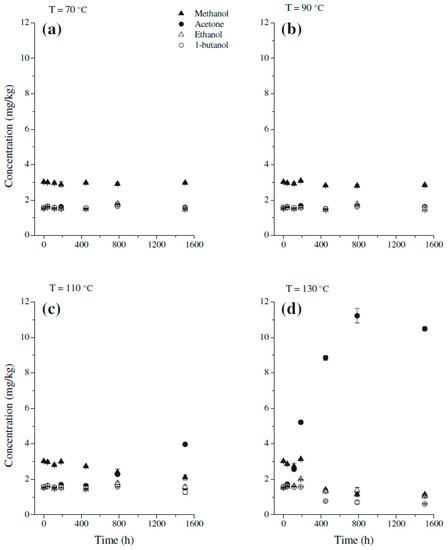
Figure 7.
Stability with time of methanol and other compounds at different temperatures (a) 70 °C, (b) 90 °C, (c) 110 °C, (d) 130 °C, from [1].
Schaut et al. [4] performed methanol stability tests with inhibited Nynas 10XN and uninhibited Nynas Nytro Libra oils. Each oil, which contained paper and copper, was aged at 120 °C for 20 days. After this period, the oil was distributed in vials that were closed under argon atmosphere. Every three weeks for a 30-week period, the vials were analyzed for methanol and other compounds. The results for Nynas Nytro Libra oil (Figure 8) showed that the methanol concentration was stable for both types of caps used on the vials (PTFE and butyl septa). The authors reported that methanol was also stable in Nynas 10XN.
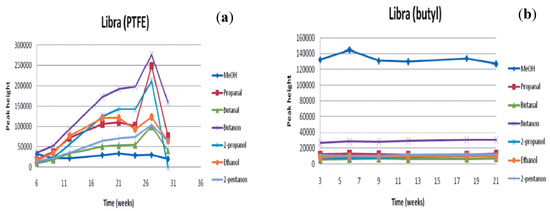
Figure 8.
Stability with time of methanol and other compounds when ageing paper in Nynas Nytro Libra oil, (a) vials with PTFE caps, (b) vials with butyl septa caps, from [4].
During accelerated laboratory ageing, some authors [29,60,62] have observed that the trend toward increasing methanol concentration with ageing duration begins to fluctuate when the paper is near its end of life, with a degree of polymerization ~200. These variations are attributed to a modification in the methanol paper/oil partitioning due to a buildup of oil oxidative products in the oil. Since this behavior is observed when insulation has reached its end of life for transformer applications, it does not affect the use of methanol as a chemical indicator.
Von Steinkirch Souza et al. [77] performed a stability study in the presence of organic acids. The goal of their study was to determine if the acids react with methanol to form esters under transformer operating conditions (75 °C). They concluded that methanol concentration was probably affected by the organic acids. In addition, its high volatility prevented replicable detection. However, some experimental parameters of their studies (e.g., ageing in glass vials with silicone septum) could have biased their results (methanol leakage through the septum). Another important parameter was the high concentration of their starting solution, 250 µL of methanol and 250 µL of acid (e.g., formic) in 2.5 mL of mineral oil. This means that the concentrations of methanol and formic acid were about 8% and 10% respectively, in the mineral oil, which indicates that the starting solution was not homogeneous. As a matter of comparison, methanol is not very soluble in oil and its presence in power transformers is in the ppb range. In addition, methanol measurements were performed in hexane-extracted solutions; the authors did not mention the extraction recovery. These experimental parameters could have had a substantial effect on the experimental results. In the discussion of results, the authors extrapolated their observations to real transformers by claiming that methanol leaks through transformer seals are to be expected [77]. However, it is important to remember that, as mentioned in previous studies [1,29], methanol partitions between the oil and the paper, with a higher affinity for the paper. Therefore, losses of methanol from the oil will be continuously equilibrated by the methanol present in the paper, as is observed in the case of moisture. The high volatility of methanol is not expected to affect reproducibility, as is the case for dissolved gas analysis (DGA), where gases with higher diffusivities provide diagnostics for power transformers.
Arroyo-Fernandez et al. [23] monitored methanol generation during ageing of cellulosic paper (standard Kraft and TUK) in synthetic ester oil (Midel 7131) and mineral oil (Luminol Tri) at 150 °C (see Figure 9). The behavior of methanol concentrations generated during the ageing of mineral oil was in accordance with previous studies. Initially (first 500 h), both oils exhibited a similar increasing trend of methanol generation. Then, the results of the ester-based oil showed a completely different trend, as the methanol concentration slowly decreased to reach a near-zero value after 2000 h, where it remained for the rest of the 8000-h period, independently of the type of paper. The authors indicated that the observed methanol behavior in synthetic esters could be caused by the higher attraction of the methanol molecules toward the synthetic ester oil matrix (fatty acids, higher acidity and polarity during ageing).
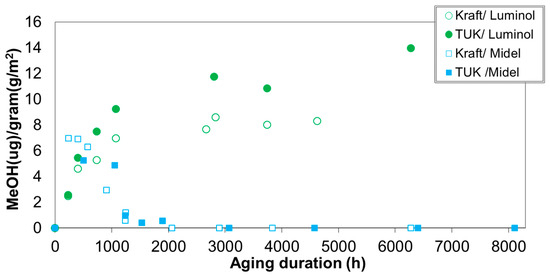
Figure 9.
Concentration of methanol with ageing time, from [23].
A recent study by Matharage et al. [6] assessed methanol generation at 80, 100 and 120 °C from standard Kraft paper ageing in synthetic ester oil (Midel 7131) and mineral oil (Gemini X). At all temperatures, methanol generation increased with ageing time. Even though the measured concentration of methanol was similar at the early stage of ageing, the authors measured a higher methanol concentration over time when synthetic ester was used. Their results, explained as resulting from different partition affinities of methanol between the ester and the paper and between the mineral oil and the paper, contribute to our understanding of temperature’s effect on the partition and stability of methanol. The authors conducted stability studies of methanol in synthetic ester at 130 °C. The spiked concentration of methanol remained constant for about seven days, then the concentration decreased with time, reaching an undetectable value after 84 days of ageing. The authors concluded that the high temperature, 130 °C, contributes to further reactions in the oil (e.g., esterification) that compromise methanol’s stability in synthetic esters.
During mineral oil ageing of cellulosic paper, methanol concentration increases with time for temperatures as high as 210 °C [29]. However, the temperature stability of methanol in esters needs to be corroborated at lower temperatures, as does the potential role of temperature (130 °C [6] and 150 °C [23]) in transesterification reactions of methanol with acids.
4. Field Measurements
The relationship between cellulose ageing and methanol generation has been demonstrated by accelerated laboratory ageing studies, as shown above. This section describes the identification of methanol during transformer oil analysis.
4.1. Power Transformers
As early as 2007, methanol has been reported in field equipment. Jalbert et al. [1] validated laboratory occurrence by tracking methanol’s presence in more than 900 equipment items (including power transformers, autotransformers, shunt reactors and grounding reactors). In the studied population, methanol was detected in 94% of cases, with concentrations higher than 10 ppm, as shown in Figure 10, where the occurrence of 2-FAL is also reported.
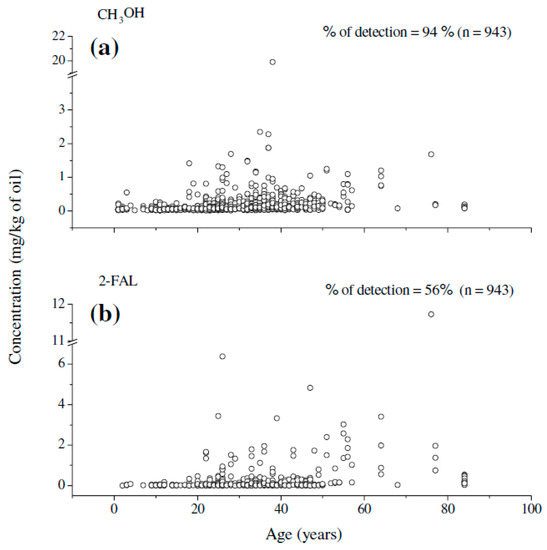
Figure 10.
Occurrence of (a) methanol and (b) 2-furfuraldehyde in oil samples collected from equipment in Hydro-Québec’s transmission network [1].
In 2011, Schaut et al. [4] presented oil analysis results from sample power transformers from several Belgian nuclear and coal-fired power plants to correlate methanol with 2-FAL concentration. Two study cases are presented; the first corresponded to a group of monophasic generator step-up (GSU) transformers, all shell-type, made by the same manufacturer, with more than 30 years in service, 160 MWA and 500 MWA, with the same type of uninhibited oil, and nitrogen-blanketed. In an eight-month period, in most of the units, 2-FAL concentration was very low or close to zero, while methanol concentration was significantly higher (up to 550 ppb). The authors concluded that the increase in methanol concentration observed during the study period might indicate some early paper degradation of the transformers. A second case involved the analysis of oil samples from triphasic power transformers at coal-fired power plants. The common characteristic of these transformers is a constant loading of 90–100% during their service life of ~40 years. The results show a relatively high concentration of 2-FAL (up to 7000 ppb) and methanol concentrations between 500 and 3000 ppb. Later the same year, the team extended their studies [24,78] to include temperature variations for the GSU transformers. They observed that methanol concentration increased proportionally to the increase in transformer temperature. This characteristic, also known as partition of methanol, was also reported by Jalbert et al. [79] and is presented in detail in Section 5 of this paper.
In 2012, Rodriguez-Celis et al. [12] presented the results of oil analysis of field power transformers at Hydro-Québec. Methanol was present together with DGA and 2-FAL. Since these transformers were in operation, DPv values were not available. Based on their results, the authors estimated that one of the studied transformers with methanol and 2-FAL values around 1500 and 2000 ppb, respectively, might exhibit advanced solid insulation degradation. In the absence of an interpretation model of the extent of cellulose degradation, only a postmortem analysis could confirm the hypothesis based on oil analysis alone. In the same year, Jalbert et al. [2] reported practical examples of in-service nuclear power plant transformers at Hydro-Québec and Électricité de France (EDF). Based on a survey of 20 field transmission transformers at Hydro-Québec, the use of methanol in conjunction with the DGA results allowed them to identify units that could be affected by an abnormal paper ageing rate, as shown in Figure 11.
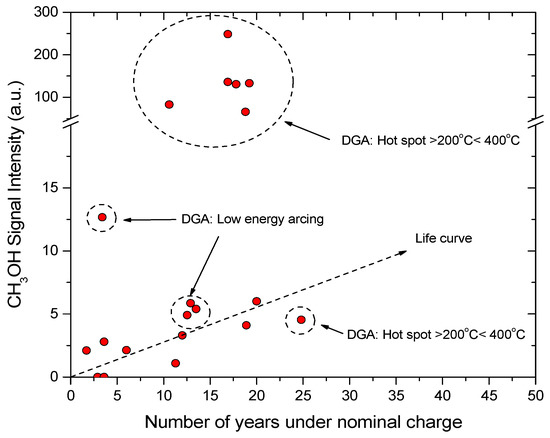
Figure 11.
Insulation transformer life curve using methanol [2].
The absence of 2-FAL was an indication that TUK paper was used instead of standard Kraft. The survey of 169 nitrogen-blanketed power plant transformers, which operate at close to 100% of their rated load, allowed for a direct comparison of the methanol concentration in these units. The characteristics of the studied transformers are presented in Table 3 and the methanol results are shown in Figure 12.

Table 3.
Characteristics of the transformers investigated [2].
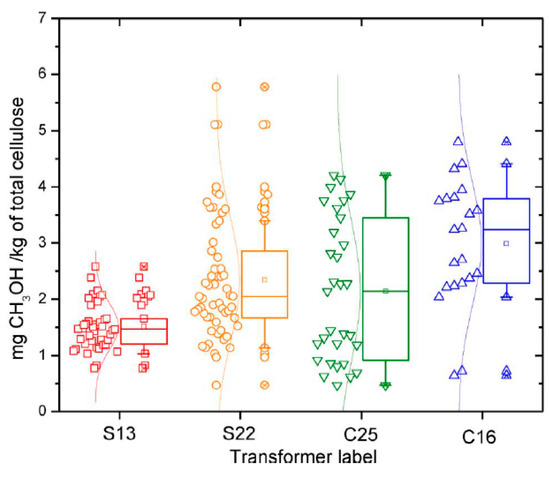
Figure 12.
Comparison of methanol marker statistics on Électricité de France’s (EDF) power plant transformers [2].
In Figure 12, knowing that both standard Kraft and TUK paper generate methanol, the results for shell-type S13 units (550–570 MWA, 13 ± 7 years of service) and S22 units (360 MWA, 22 ± 4 years of service) were as expected. For approximately the same service duration 22 ± 4 (S22) compared to 25 ± 3 (C25) and power (360 MWA), the average concentration (square dot on the Whisker graph) is slightly higher for S22. The difference, although minimal, could be explained by the highest operating temperature attributed to the shell configuration. The higher methanol concentrations found in the C16 core transformers (550 MWA) could be an indication of further cellulose degradation compared to the other types. The results highlight the importance of comparing similarly configured transformers. The ideal scenario is to obtain as much information as possible on the type and quantity of insulation materials involved (paper/board/oil) in order to normalize the data. The authors also mention the ability of methanol to rapidly re-equilibrate after oil regeneration, which is another advantage of this marker.
Another interesting application of methanol is monitoring its generation during the thermal performance qualification of new power transformers. Ryadi et al. [80] track the occurrence of this marker during the standard heat run test of three GSU transformers. During each thermal test, sampling syringes were taken for laboratory oil analysis. The results show that the concentration of methanol, although detected, did not change significantly during the tests. This could be due to a low temperature rise, the absence of a hot spot (as per DGA results), or even an inappropriate equilibration time for methanol.
A detailed assessment of sister units, transformers with the same design and operating conditions, was presented by Ryadi et al. [81]. In their study, a set of six GSU transformers (340 MVA/420 kV, ODAF cooling) with more than 25 years of operation were monitored based on chemical markers (DGA, 2-FAL and CH3OH). The units were filled with uninhibited mineral oil and Kraft cellulosic material as solid insulation. Following the failure of one of the units, a postmortem analysis (DPv measurement) was performed. The authors’ goal was to closely monitor the five remaining units in the power station. Before the equipment failure, DGA results (Rogers ratios) indicated that a thermal defect of low temperature origin affected some of the transformers; the carbon oxide ratios indicated that paper was implicated in the defect. Overall, the DGA results for the faulty unit (Unit 5) did not indicate a potential malfunction, although online monitoring could have provided knowledge of the transformer’s status during the last period of operation. The characterization of the failed unit based on 2-FAL concentration indicated an estimated average DPv of 400. The authors indicated, however, that the estimation could have been influenced by the oil’s acidity, 0.18 mg KOH/g. No information on methanol concentration was available for the failed unit. During postmortem analysis, a weak area on top of the LV winding (DPv 300–400) was identified. This result was in agreement with the electromagnetic field plotting where the radial components of the strat flux were at their maximum. The HV winding had an average DPv of between 700 and 800. The diagnostic analysis of the five remaining units in operation indicated that two of them were more advanced in terms of ageing. Within the maintenance operation process, oil processing was carried out and the marker concentration was investigated. As observed in previous studies, the methanol concentration was found to re-equilibrate faster than the 2-FAL.
Wang et al. [82] investigated methanol in approximately 190 transformers in the United Kingdom. These transformers are free breathing and have standard Kraft paper for the solid insulation. Figure 13 shows the measured methanol concentration, which, as expected, increases with in-service time. The authors indicated that the measured concentrations could depend on transformer temperature, oil-paper ratio and methanol volatility through the breather and that these factors should be considered when making interpretations.
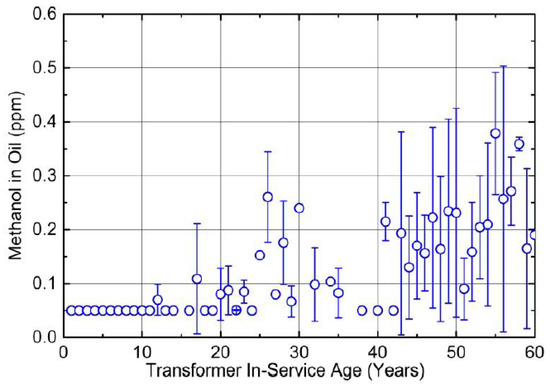
Figure 13.
Variation in methanol for in-service aged transformer oil samples [82].
4.2. Distribution Transformers
Assessment of transformer condition by analyzing oil samples is primarily reserved for power transformers. Therefore, few published works are available on field applications in distribution transformers. In 2012, Rodriguez-Celis et al. [12] associated their laboratory observations with oil samples from Hydro-Québec distribution transformers. A survey of more than 100 transformers was performed, and based on the results, 20 were selected for postmortem analysis. Table 4 shows the chemical marker results and DPv for three typical units. According to these results, unit A seems to show early signs of cellulose degradation. However, unit B shows a higher concentration of methanol and 2-FAL, which could be related to the ageing of the lead, which is near the end of its lifetime, while the winding paper DPv shows only early degradation. The lead is crepe paper that has been mechanically treated and is of a different type than the winding (Kraft) paper. In unit C, ethanol concentration is higher than methanol concentration, which has been reported to be caused by higher temperatures in the transformer [83]. A visual inspection of the paper in this unit showed blackened areas, confirming the presence of hot spots in the transformer.

Table 4.
Analysis of field-distribution transformers [12].
Bertrand et al. [7] conducted a laboratory study to identify cellulose ageing markers that could be useful for the management of MV/LV distribution transformers. The authors concluded that methanol and 2-FAL were useful to predict the cellulose insulation’s DPv. Correlation models of marker concentration and DPv, based on laboratory results, are presented. Later, the same team [84] included the results of oil analysis and postmortem of MV/LV distribution transformers with 26–55 years of service. These sealed transformers were rated between 25 and 400 kVA and operated at 15 or 20 kV/400 V (low load condition); they were filled with uninhibited mineral oil. Methanol was found in 26 of the 28 transformers where oil analysis was performed, with concentrations ranging between 30 and 2700 ppb. In contrast, 2-FAL was detected in only seven of the units. Even though three units were retro filled shortly before the study, they contained detectable amounts of methanol, despite its expected decrease in concentration. This behavior, also observed in [2], is explained by the methanol equilibrium between the oil and the paper. Even though the oil was removed, the remaining methanol in the paper is expected to equilibrate in the new oil (as presented in Section 5.2 on the effect of transformer oil interventions). The authors concluded that the concentration of methanol in samples of transformer oil is a more promising screening criterion than 2-FAL and suggested that a correlation between the laboratory findings and results from field transformers is needed to assess transformer end of life.
Bare et al. [85,86] compared 2-FAL and methanol concentrations from seven distribution transformers that had been in service for 16 years. The transformers had TUK paper as solid insulation. 2-FAL was monitored over a period of approximately 10 years, with concentration results close to zero, which could erroneously indicate that the paper had not aged at all. Gilbert et al. demonstrated that the absence of 2-FAL is a characteristic when TUK insulation is used [28]. For these transformers, methanol information was available only for the last year; the concentration results were extrapolated to a DPv value below 1000. The authors emphasized that the monitoring of methanol could allow one to track changes in DPv for diagnostic purposes.
5. Effect of Transformer Oil Parameters
5.1. Partitioning
Paper-oil systems interact differently with the various by-products generated. Indeed, oil is a nonpolar material compared to the very polar cellulosic paper. This difference leads to a partitioning phenomenon between the two materials. Similarly to water, the majority of methanol (CH3OH) is held in the cellulose and equilibrated in the oil depending on the physico-chemical parameters. The first parameter influencing this equilibrium is temperature. When the temperature increases, methanol is extracted from the cellulose and its concentration in the oil increases. This aspect was studied for different markers including 2-FAL [79]. In Figure 14, the authors varied the temperature from about 20 to 90 °C; once the temperature was stable, they took oil aliquots and measured the markers until they reached equilibrium. They concluded that oil rapidly reaches temperature equilibrium. The relative rapidity of the various molecules in reaching this equilibrium is as follows:
H2O > CH3OH > CH3CH2OH >> 2-FAL.
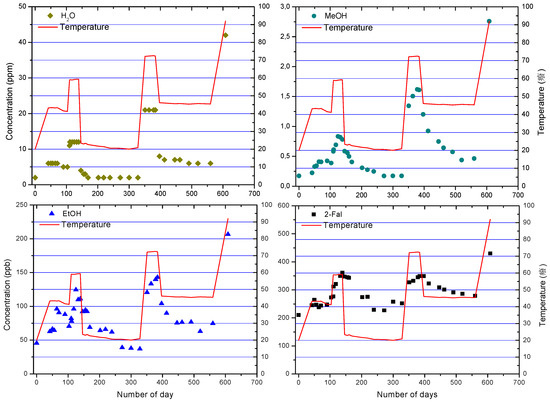
Figure 14.
Typical temperature profile and behavior of various molecules: H2O, CH3OH, CH3CH2OH and 2-FAL [79].
Using these results, they established the behavior of the correction factors (CfM) with the temperature and obtained the following equation.
where a (dimensionless) and b (1/°C) are coefficients represented in Table 5 and Ts is the oil temperature when sampled. Finally, in order to correct the concentrations of the markers at 20 °C, this formula is used:
[M]20 °C = [M]Ts x CfM.

Table 5.
Equation parameters for the chemical markers studied.
[M]20 °C is the marker concentration at 20 °C, [M]Ts is the marker concentration at the oil temperature when sampled, “x” denotes multiplication, and CfM is the corresponding correction factor for the marker.
This type of correction helps one to track cellulose degradation behavior more accurately throughout the transformer’s life. This is an unavoidable aspect of any marker for which a partitioning phenomenon exists between two materials. Other parameters may affect partitioning, such as acidity and moisture, but they are still under investigation.
5.2. Effect of Transformer Oil Interventions
With the experimental approach used in the previous section, it is possible to imagine how an oil intervention like oil degassing or regeneration will impact the methanol concentration. Indeed, given that the majority of methanol remains in the cellulose, when an oil intervention is executed, the methanol dissolved in the oil will be removed. After the transformer is re-energized and a certain amount of time has passed, a new equilibrium will be reached and the first molecules that equilibrate will be water and methanol. This behavior was demonstrated before the partitioning study [79]: about three months after oil processing, methanol reached its equilibrium [2].
6. Interpretation Model
The challenges of all indirect correlations relate to the accuracy of the interpretation model. This model needs to take into account all the influencing transformer parameters such as design, oil-to-paper ratio, etc. In a recent publication, Jalbert et al. [87] proposed an interpretation model based on transformer postmortem analysis. They analyzed the DPv of 20 core-type power transformers. For each transformer, more than 100 DPv measurements were taken. Moreover, they showed that, for one manufacturer, the paper-to-board ratio was practically constant for transformers with different voltage levels built in the last 15 years (Figure 15a). This means that the partition of the methanol between the paper and board will be constant for a specific temperature. They also showed that the winding paper weight was relatively proportional to the oil weight, independently of the transformer’s design and size (Figure 15b). Since the methanol concentration depends on the paper-oil ratio and seems to increase proportionally, this behavior indicates that the degradation level of the cellulose using the oil-soluble marker can be tracked for all transformer designs.
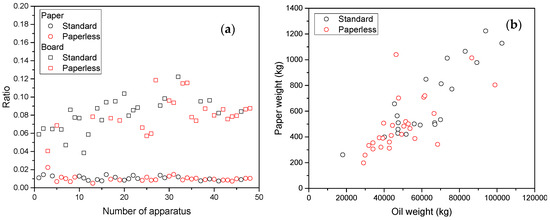
Figure 15.
(a) Ratio of solid insulation of different core-type transformers. (b) Paper weight versus oil weight for different core-type transformers [87].
Thus, Jalbert et al. [87] transposed a kinetic equation for cellulose depolymerization (see Section 2.3) to a kinetic equation for methanol formation.
DP0 is the initial level of DPv found in a transformer after drying, which is about 1000; DPt is the DPv at time t; the coefficients Ja and Jc are the number of methanol molecules produced by chain scissions in the amorphous and crystalline phases, respectively, with their corresponding formation rates ka and kc. Since methanol concentration increases directly with time, the authors proposed a substitution in Equation (12), then plotted the weighted average mean number of scissions against the methanol concentration, corrected at 20 °C. The results are shown in Figure 16. In this figure, the numbers in blue identify 18 of the 20 core-type power transformers that were analyzed. Values for the two remaining units, 10 and 12, indicated in red, were outside the observed data tendency.
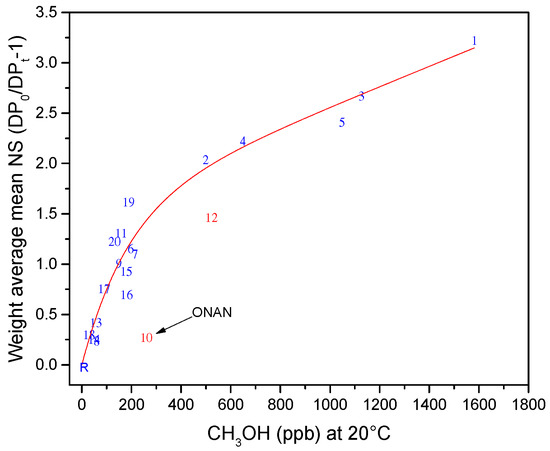
Figure 16.
Methanol prediction model for core-type transformers [87].
This curve gives the following interpretation model:
or
[CH3OH] is the concentration of methanol in ppb corrected at 20 °C. This model has a good correlation with r2 = 0.94103. Using this model, the authors developed threshold values based on what it is stipulated for 2-FAL [88]. These threshold values are reported in Table 6.

Table 6.
Methanol threshold level and its condition [87].
7. Normalization
In 2010, ASTM became the first entity to start normalizing the analytical method [17]. The method is now on its third ballot and will probably be accepted in 2019. Meanwhile, IEC started the same process in 2015 [16], performing two round robins. The method seems appropriate for the analysis of methanol in mineral oil, but the use of ester fluids needs further research in order to understand the interactions between this type of fluid and methanol.
8. The Future of Methanol
Methanol as a chemical marker for the detection of insulating paper degradation in transformer insulating oil is a mature approach for use in industry. The determination of methanol in transformer oil dates back more than 10 years thanks to concrete research efforts based on accelerated laboratory ageing and validation with field samples. In addition to DGA by online monitoring, it is not difficult to imagine a future where methanol concentration in a transformer could be determined in real time. In addition to transformers, methanol’s applicability could be extended to other pieces of equipment such as bushings, reactors, etc.
Nevertheless, there is still work to be done to assess the effect of high moisture and/or oil acidity, which could affect methanol partition. Methanol partition has also been observed, depending on the type of paper—standard Kraft or TUK. Further studies are needed to understand this behavior and propose correction factors, depending on the partition impact.
An interpretation methodology, built with real postmortem transformer data, allows one to assess the paper’s condition. This model could be added as a health index parameter for transformer end users who manage transformer fleet investments. However, further studies are needed to establish the lowest DPv in a transformer that can be estimated by this interpretation methodology, since it may depend on the cooling system.
This review has addressed methanol generation from standard Kraft and thermally upgraded (TUK) papers in mineral oils. With the appearance of new types of solid insulation (e.g., cellulose-aramid hybrid papers) and the presence of natural and synthetic ester fluids for liquid insulation, it is expected that methanol concentrations may differ. Therefore, future work should evaluate methanol concentrations when a combination of these insulation materials is present in a transformer.
Author Contributions
All authors have contributed on the preparation of this review manuscript and have been active on the field of methanol as a chemical marker since its early detection in transformer oil.
Funding
The authors sincerely acknowledge Hydro-Québec Research Institute (IREQ) for the financial support granted for the preparation of this review paper. This research received no external funding.
Conflicts of Interest
The authors declare no conflict of interest.
References
- Jalbert, J.; Gilbert, R.; Tetreault, P.; Morin, B.; Lessard-Deziel, D. Identification of a chemical indicator of the rupture of 1,4-B-glycosidic bonds of cellulose in an oil impregnated insulating paper system. Cellulose 2007, 14, 295–309. [Google Scholar] [CrossRef]
- Jalbert, J.; Gilbert, R.; Denos, Y.; Gervais, P. Methanol: A Novel Approach to Power Transformer Asset Management. IEEE Trans. Power Deliv. 2012, 27, 514–520. [Google Scholar] [CrossRef]
- Jalbert, J.; Besner, S. Methanol as a chemical indicator of insulating paper ageing in power transformers. In Advanced Monitoring and Modelling Methods for Power Transformer Asset Management. Eur. J. Electr. Eng. 2010, 13, 591–620. [Google Scholar]
- Schaut, A.; Autru, S.; Eeckhoudt, S. Applicability of methanol as new marker for paper degradation in power transformers. IEEE Trans. Dielectr. Electr. Insul. 2011, 18, 533–540. [Google Scholar] [CrossRef]
- Matharage, S.Y.; Liu, Q.; Wang, Z.D. Aging assessment of kraft paper insulation through methanol in oil measurement. IEEE Trans. Dielectr. Electr. Insul. 2016, 23, 1589–1596. [Google Scholar] [CrossRef]
- Matharage, S.Y.; Liu, Q.; Wang, Z.D.; Wilson, G.; Krause, C. Aging assessment of synthetic ester impregnated thermally non-upgraded kraft paper through chemical markers in oil. IEEE Trans. Dielectr. Electr. Insul. 2018, 25, 507–515. [Google Scholar] [CrossRef]
- Bertrand, Y.; Tran-Duy, C.; Murin, V.; Annelore, S.; Stijn, A.; Eeckhoudt, S. MV/LV distribution transformers: Research on paper ageing markers. In Proceedings of the CIGRE 2012, Paris, France, 26–31 August 2012. [Google Scholar]
- Perrier, C.; Molle-Epain, C.; Coulibaly, M.-L.; Vigneron, V.; Minniti, X.; Michellon, C. Methanol as promising tool for lifetime management of cellulosic insulation. In Proceedings of the MatPost, Lyon, France, 25 November 2015. [Google Scholar]
- Perrier, C.; Coulibaly, M.L.; Marugan, M. Methanol as new ageing marker of oil-filled transformer insulation. In Proceedings of the 23rd International Conference on Electricity Distribution, Lyon, France, 15–18 June 2015. [Google Scholar]
- Coulibaly, M.L.; Perrier, C.; Marugan, M. Assesment of Methanol as cellulose aging marker in mineral and ester oil. In Proceedings of the CIGRE, Paris, France, 21–26 August 2016. [Google Scholar]
- Matharage, S.Y.; Liu, Q.; Wang, Z.D.; Wilson, G.; Dyer, P.; Mavrommatis, P. Generation of methanol and ethanol from inhibited mineral oil. In Proceedings of the 2017 INSUCON-13th International Electrical Insulation Conference (INSUCON), Birmingham, UK, 16–18 May 2017; pp. 1–4. [Google Scholar]
- Rodriguez-Celis, E.; Jalbert, J.; Duchesne, S.; Noirhomme, B.; Lessard, M.; Ryadi, M. Chemical markers use for the diagnosis and life estimation of power transformers: A preliminary study of their origins. In Proceedings of the CIGRÉ Canada Conference, Montreal, QC, Canada, 24–26 September 2012. [Google Scholar]
- Mohamed Ryadi, A.T.; Jalbert, J.; Rajotte, C. Alcohols based ageing chemical markers for the diagnosis of transformer cellulosic insulation. In Proceedings of the Cigre SC A2 & D1 Joint Colloquium, Kyoto, Japan, 11–16 September 2011. [Google Scholar]
- Ryadi, M.; Jalbert, J.; Lessard, M.-C. Power Transformers Aging Diagnostic: Methanol from the Lab to the Field. In Proceedings of the TechCon North America 2017, Houston, TX, USA, 14–16 February 2017. [Google Scholar]
- On behalf of CIGRE JWG A2/D1.46. Field Experience with Transformer Solid Insulation Ageing Markers, CIGRE Technical Brochure. Accepted for publication. 2019.
- On behalf of IEC TC10 WG 63025. Quantitative Determination of Methanol and Other Light Alcohols in Insulating Liquids-Part 1: Method for Mineral Insulating Oils-Part 2: Method for Non Mineral Insulating Liquids International Electrotechnical Commission (IEC). to be published.
- On behalf of ASTM WG D27 WK30948. American Society for Testing and Materials, The Determination of Methanol and Ethanol in Electrical Insulating Liquids by Headspace (HS)-Gas Chromatography (GC) Using Mass Spectrometry (MS) or Flame Ionization Detection (FID). ASTM, Standard under ballot process.
- Bruzzoniti, M.C.; Maina, R.; De Carlo, R.M.; Sarzanini, C.; Tumiatti, V. GC methods for the determination of methanol and ethanol in insulating mineral oils as markers of cellulose degradation in power transformers. Chromatographia 2014, 77, 1081–1089. [Google Scholar] [CrossRef]
- Jalbert, J.; Duchesne, S.; Rodriguez-Celis, E.; Tétreault, P.; Collin, P. Robust and sensitive analysis of methanol and ethanol from cellulose degradation in mineral oils. J. Chromatogr. A 2012, 1256, 240–245. [Google Scholar] [CrossRef]
- Molavi, H.; Yousefpour, A.; Mirmostafa, A.; Sabzi, A.; Hamedi, S.; Narimani, M.; Abdi, N. Static Headspace GC/MS Method for Determination of Methanol and Ethanol Contents, as the Degradation Markers of Solid Insulation Systems of Power Transformers. Chromatographia 2017, 80, 1129–1135. [Google Scholar] [CrossRef]
- Matharage, S.Y.; Liu, Q.; Davenport, E.; Wilson, G.; Walker, D.; Wang, Z.D. Methanol detection in transformer oils using gas chromatography and ion trap mass spectrometer. In Proceedings of the 2014 IEEE 18th International Conference on Dielectric Liquids (ICDL), Manchester, UK, 29 June–3 July 2014; pp. 1–4. [Google Scholar]
- Skoog, D.A.; Holler, F.J.; Crouch, S.R. Principles of Instrumental Analysis; Cengage Learning: Boston, MA, USA, 2007. [Google Scholar]
- Arroyo-Fernández, O.H.; Fofana, I.; Jalbert, J.; Gagnon, S.; Rodriguez-Celis, E.; Duchesne, S.; Ryadi, M. Aging characterization of electrical insulation papers impregnated with synthetic ester and mineral oil: Correlations between mechanical properties, depolymerization and some chemical markers. IEEE Trans. Dielectr. Electr. Insul. 2018, 25, 217–227. [Google Scholar] [CrossRef]
- Schaut, A.; Autru, S.; Eeckhoudt, S. Applicability of methanol as early stage paper degradation marker. In Proceedings of the CIGRE, Kyoto, Japan, 11–16 September 2011. [Google Scholar]
- Jalbert, J.; Lacasse, R.; El Khakani, M.A.; Gilbert, R. Accelerated ageing of wood Kraft insulating paper by means of a pulsed KrF excimer laser radiation. Appl. Phys. A 2005, 81, 57–63. [Google Scholar] [CrossRef]
- Jalbert, J.; Lacasse, R.; El Khakani, M.A.; Gilbert, R. Pulsed KrF excimer laser induced degradation of cellulose based insulating paper. Cellulose 2009, 16, 863–876. [Google Scholar] [CrossRef]
- Gilbert, R.; Jalbert, J.; Tétreault, P.; Morin, B.; Denos, Y. Kinetics of the production of chain-end groups and methanol from the depolymerization of cellulose during the ageing of paper/oil systems. Part 1: Standard wood kraft insulation. Cellulose 2009, 16, 327–338. [Google Scholar] [CrossRef]
- Gilbert, R.; Jalbert, J.; Duchesne, S.; Tétreault, P.; Morin, B.; Denos, Y. Kinetics of the production of chain-end groups and methanol from the depolymerization of cellulose during the ageing of paper/oil systems. Part 2: Thermally-upgraded insulating papers. Cellulose 2010, 17, 253–269. [Google Scholar] [CrossRef]
- Jalbert, J.; Rodriguez-Celis, E.; Duchesne, S.; Morin, B.; Ryadi, M.; Gilbert, R. Kinetics of the production of chain-end groups and methanol from the depolymerization of cellulose during the ageing of paper/oil systems. Part 3: Extension of the study under temperature conditions over 120 °C. Cellulose 2015, 22, 829–848. [Google Scholar] [CrossRef]
- Arroyo, O.H.; Jalbert, J.; Fofana, I.; Ryadi, M. Temperature dependence of methanol and the tensile strength of insulation paper: Kinetics of the changes of mechanical properties during ageing. Cellulose 2017, 24, 1031–1039. [Google Scholar] [CrossRef]
- Ekenstam, A. Über das Verhalten der Cellulose in Mineralsäure-Lösungen, II. Mitteil.: Kinetisches Studium des Abbaus der Cellulose in Säure-Lösungen. Ber. Dtsch. Chem. Ges. 1936, 69, 553–559. [Google Scholar] [CrossRef]
- Calvini, P. The role of the Ekenstam equation on the kinetics of cellulose hydrolytic degradation. Cellulose 2012, 19, 313–318. [Google Scholar] [CrossRef]
- Calvini, P. On the meaning of the Emsley, Ding & Wang and Calvini equations applied to the degradation of cellulose. Cellulose 2014, 21, 1127–1134. [Google Scholar] [CrossRef]
- Emsley, A.M.; Heywood, R.J.; Ali, M.; Eley, C.M. On the kinetics of degradation of cellulose. Cellulose 1997, 4, 1–5. [Google Scholar] [CrossRef]
- Ding, H.Z.; Wang, Z.D. On the degradation evolution equations of cellulose. Cellulose 2008, 15, 205–224. [Google Scholar] [CrossRef]
- Calvini, P.; Gorassini, A.; Merlani, A.L. On the kinetics of cellulose degradation: Looking beyond the pseudo zero order rate equation. Cellulose 2008, 15, 193–203. [Google Scholar] [CrossRef]
- Calvini, P. Comments on the article “On the degradation evolution equations of cellulose” by Hongzhi Ding and Zhongdong Wang. Cellulose 2008, 15, 225–228. [Google Scholar] [CrossRef]
- Calvini, P.; Gorassini, A. On the Rate of Paper Degradation: Lessons from the Past. Restaurator 2006, 27, 275–290. [Google Scholar] [CrossRef]
- Calvini, P.; Gorassini, A. Surface and bulk reactions of cellulose oxidation by periodate. A simple kinetic model. Cellulose 2012, 19, 1107–1114. [Google Scholar] [CrossRef]
- De Pablo, A. Furfural and ageing: How are they related. In Proceedings of the IEE Colloquium on Insulating Liquids, Leatherhead, UK, 27 May 1999; p. 5. [Google Scholar]
- Hill, D.J.T.; Le, T.T.; Darveniza, M.; Saha, T. A study of degradation of cellulosic insulation materials in a power transformer. Part 2: Tensile strength of cellulose insulation paper. Polym. Degrad. Stab. 1995, 49, 429–435. [Google Scholar] [CrossRef]
- McNutt, W. Insulation thermal life considerations for transformer loading guides. IEEE Trans. Power Deliv. 1992, 7, 392–401. [Google Scholar] [CrossRef]
- Oommen, T.V.; Prevost, T.A. Cellulose insulation in oil-filled power transformers: Part II maintaining insulation integrity and life. IEEE Electr. Insul. Mag. 2006, 22, 5–14. [Google Scholar] [CrossRef]
- Duval, M.; Pablo, A.D.; Atanasova-Hoehlein, I.; Grisaru, M. Significance and detection of very low degree of polymerization of paper in transformers. IEEE Electr. Insul. Mag. 2017, 33, 31–38. [Google Scholar] [CrossRef]
- Shroff, D.H.; Stannett, A.W. A review of paper aging in power transformers. IEE Proc. C 1985, 132, 312–319. [Google Scholar] [CrossRef]
- Emsley, A.M.; Heywood, R.J.; Ali, M.; Xiao, X. Degradation of cellulosic insulation in power transformers 4. Effects of ageing on the tensile strength of paper. IEE Proc. Sci. Meas. Technol. 2000, 147, 285–290. [Google Scholar] [CrossRef]
- He, J. Quantitative Study of Paper Structure at the Fibre Level for Development of a Model for the Tensile Strength of Paper. Ph.D. Thesis, Monash University, Melbourne, Australia, 2005. [Google Scholar]
- Cox, H.L. The elasticity and strength of paper and other fibrous materials. Br. J. Appl. Phys. 1952, 3, 72. [Google Scholar] [CrossRef]
- Shen, B. Variation in the Local Structure and Properties of Paper. Ph.D. Thesis, University of Toronto, Toronto, ON, Canada, 2000. [Google Scholar]
- Kortschot, M. The role of the fiber in the structural hierarchy of paper. In Proceedings of the 11th Fundamentals of Papermaking Materials Transactions of the Fundamental Research Symposium, Cambridge, UK, 21–26 September 1997; pp. 351–399. [Google Scholar]
- Dodson, C.T.J. The nature of bonds in paper and the behaviour of paper under mechanical strain. Rep. Prog. Phys. 1970, 33, 1. [Google Scholar] [CrossRef]
- Lundgaard, L.E.; Hansen, W.; Linhjell, D.; Painter, T.J. Aging of oil-impregnated paper in power transformers. IEEE Trans. Power Deliv. 2004, 19, 230–239. [Google Scholar] [CrossRef]
- Kato, K.; Cameron, R. A review of the relationship between thermally-accelerated ageing of paper and hornification. Cellulose 1999, 6, 23–40. [Google Scholar] [CrossRef]
- Diniz, J.F.; Gil, M.; Castro, J. Hornification—Its origin and interpretation in wood pulps. Wood Sci. Technol. 2004, 37, 489–494. [Google Scholar] [CrossRef]
- Darveniza, M.; Saha, T.K.; Hill, D.J.T.; Le, T.T. Investigations into effective methods for assessing the condition of insulation in aged power transformers. IEEE Trans. Power Deliv. 1998, 13, 1214–1223. [Google Scholar] [CrossRef]
- ASTM. ASTM D202 Standard Test Methods for Sampling and Testing Untreated Paper Used for Electrical Insulation; ASTM: West Conshohocken, PA, USA, 2002. [Google Scholar]
- Zou, X.; Gurnagul, N.; Uesaka, T.; Bouchard, J. Accelerated aging of papers of pure cellulose: Mechanism of cellulose degradation and paper embrittlement. Polym. Degrad. Stab. 1994, 43, 393–402. [Google Scholar] [CrossRef]
- Lawson, W.G.; Simmons, M.A.; Gale, P.S. Thermal Ageing of Cellulose Paper Insulation. IEEE Trans. Electr. Insul. 1977, EI-12, 61–66. [Google Scholar] [CrossRef]
- Morrison, E.L. Evaluation of the Thermal Stability of Electrical Insulating Paper. IEEE Trans. Electr. Insul. 1968, EI-3, 76–82. [Google Scholar] [CrossRef]
- Arroyo-Fernández, O.H.; Fofana, I.; Jalbert, J.; Rodriguez, E.; Rodriguez, L.B.; Ryadi, M. Assessing changes in thermally upgraded papers with different nitrogen contents under accelerated aging. IEEE Trans. Dielectr. Electr. Insul. 2017, 24, 1829–1839. [Google Scholar] [CrossRef]
- Arroyo, O.H.; Fofana, I.; Jalbert, J.; Ryadi, M. Relationships between methanol marker and mechanical performance of electrical insulation papers for power transformers under accelerated thermal aging. IEEE Trans. Dielectr. Electr. Insul. 2015, 22, 3625–3632. [Google Scholar] [CrossRef]
- Arroyo, O.H.; Fofana, I.; Jalbert, J. Relationship between some chemical markers and the mechanical properties of the solid insulation used in power transformers. In Proceedings of the 2014 IEEE Electrical Insulation Conference (EIC), Philadelphia, PA, USA, 8–11 June 2014; pp. 348–352. [Google Scholar]
- Liu, Q.; Wang, Z.; Jarman, P.; Azis, N.; Sampson, W.; Heywood, R.J. Assessment of ageing conditions through paper tensile strength analysis of scrapped transformers. In Proceedings of the 16th International Symposium on High Voltage Engineering, Cape Town, South Africa, 24–28 August 2009. [Google Scholar]
- McShane, C.P.; Rapp, K.J.; Corkran, J.L.; Gauger, G.A.; Luksich, J. Aging of paper insulation in natural ester dielectric fluid. In Proceedings of the 2001 IEEE/PES Transmission and Distribution Conference and Exposition. Developing New Perspectives, Atlanta, GA, USA, 2 November 2001; Volume 672, pp. 675–679. [Google Scholar]
- Clark, F.M. Insulating Materials for Design and Engineering Practice; Wiley: New York, NY, USA, 1962. [Google Scholar]
- Unsworth, J.; Mitchell, F. Degradation of electrical insulating paper monitored with high performance liquid chromatography. IEEE Trans. Electr. Insul. 1990, 25, 737–746. [Google Scholar] [CrossRef]
- Azis, N.; Liu, Q.; Wang, Z. Ageing assessment of transformer paper insulation through post mortem analysis. IEEE Trans. Dielectr. Electr. Insul. 2014, 21, 845–853. [Google Scholar] [CrossRef]
- Youssouf, R.M.; Meghnefi, F.; Fofana, I. Frequency response analyses via rational function fitting. In Proceedings of the 2012 Annual Report Conference on Electrical Insulation and Dielectric Phenomena, Montreal, QC, Canada, 14–17 October 2012; pp. 230–233. [Google Scholar]
- Verma, P.; Chauhan, D.S.; Singh, P. Effects on tensile strength of transformer insulation paper under accelerated thermal and electrical stress. In Proceedings of the 2007 Annual Report—Conference on Electrical Insulation and Dielectric Phenomena, Vancouver, BC, Canada, 14–17 October 2007; pp. 619–622. [Google Scholar]
- TAPPI test method T494: Tensile Properties of Paper and Paperboard TAPPI, Ed. 2006. Available online: https://www.tappi.org/content/sarg/t494.pdf (accessed on 14 October 2019).
- Naranpanawe, W.; Bandara, K.; Saha, T.; Ekanayake, C.; Annamalai, P.K. Effect of pressboard ageing on power transformer mechanical vibration characteristics. In Proceedings of the Power and Energy Engineering Conference (APPEEC), Brisbane, Australia, 15–18 November 2015; pp. 1–5. [Google Scholar]
- Homagk, C.; Mossner, K.; Leibfried, T. Investigation on Degradation of Power Transformer Solid Insulation Material. In Proceedings of the 2008 Annual Report Conference on Electrical Insulation and Dielectric Phenomena, Quebec, QC, Canada, 26–29 October 2008; pp. 75–78. [Google Scholar]
- Prevost, T.A.; Oommen, T.V. Cellulose insulation in oil-filled power transformers: Part I-history and development. IEEE Electr. Insul. Mag. 2006, 22, 28–35. [Google Scholar] [CrossRef]
- Yamagata, N.; Miyagi, K.; Oe, E. Diagnosis of thermal degradation for thermally upgraded paper in mineral oil. In Proceedings of the International Conference on Condition Monitoring and Diagnosis, Beijing, China, 21–24 April 2008; pp. 1000–1004. [Google Scholar]
- Chendong, X. Monitoring paper insulation aging by measuring furfural contents in oil. In Proceedings of the 7th International Symposium on High Voltage Engineering, Dresden, Germany, 26–30 August 1991; p. 139. [Google Scholar]
- Arroyo Fernández, O.H. Étude des Corrélations Entre les Propriétés Mécaniques des Papiers et les Traceurs Chimiques Issus de Son Vieillissement Pour Surveiller L’état de L’isolation Solide des Transformateurs de Puissance. Ph.D. Thesis, Université du Québec à Chicoutimi, Chicoutimi, QC, Canada, 2017. [Google Scholar]
- Prux von Steinkirch Souza, E.M.; Mildemberger, L.; Akcelrud, L.; Andreoli, M.C.; Dos Santos, K.; Da Silva, C.; Nunes Da Motta, H.; Gulmine, J.V.; Munaro, M. Evaluation of the chemical stability of methanol generated during paper degradation in power transformers. IEEE Trans. Dielectr. Electr. Insul. 2016, 23, 3209–3214. [Google Scholar] [CrossRef]
- Schaut, A.; Eeckhoudt, S. Identification of early-stage paper degradation by methanol. In Proceedings of the CIGRÉ Conference 2012, Paris, France, 26–31 August 2012; Available online: https://e-cigre.org/publication/A2-107_2012-identification-of-early-stage-paper-degradation-by-methanol (accessed on 14 October 2019).
- Jalbert, J.; Lessard, M.C.; Ryadi, M. Cellulose chemical markers in transformer oil insulation Part 1: Temperature correction factors. IEEE Trans. Dielectr. Electr. Insul. 2013, 20, 2287–2291. [Google Scholar] [CrossRef]
- Ryadi, M.; Tanguy, A.; Jalbert, J. Methanol marker for the thermal performance qualification of power transformers. In Proceedings of the 2013 IEEE Electrical Insulation Conference (EIC), Ottawa, ON, Canada, 2–5 June 2013; pp. 387–391. [Google Scholar]
- Ryadi, M.; Jalbert, J. Assesment of field power transformers insulation using aging markers. In Proceedings of the 2014 IEEE Electrical Insulation Conference (EIC), Philadelphia, PA, USA, 8–11 June 2014; pp. 338–343. [Google Scholar]
- Wang, Z.D.; Jarman, P.; Wilson, G.; Hooton, R.; Walker, D.; Dyer, P.; Krause, C.; Smith, P.W.R.; Gyore, A.; Martin, R.; et al. Condition Monitoring and Diagnostic Assessment of Transformers. In Proceedings of the CIGRÉ Conference 2016, Paris, France, 21–26 August 2016. [Google Scholar]
- Rodriguez-Celis, E.M.; Duchesne, S.; Jalbert, J.; Ryadi, M. Understanding ethanol versus methanol formation from insulating paper in power transformers. Cellulose 2015, 22, 3225–3236. [Google Scholar] [CrossRef]
- Laurichesse, D.; Bertrand, Y.; Tran-Duy, C.; Murin, V. Ageing diagnosis of MV/LV distribution transformers via chemical indicators in oil. In Proceedings of the 2013 IEEE Electrical Insulation Conference (EIC), Ottawa, ON, Canada, 2–5 June 2013; pp. 464–468. [Google Scholar]
- Bare, C.E.; Merritt, S.Y. Methanol as an ageing marker for in service transformers. In Proceedings of the 2017 Annual Pulp, Paper and Forest Industries Technical Conference (PPFIC), Tacoma, WA, USA, 18–23 June 2017; pp. 1–7. [Google Scholar]
- Bare, C.E.; Merritt, S.Y. Methanol as an Ageing Marker for In Service Transformers. IEEE Trans. Ind. Appl. 2018, 54, 6598–6602. [Google Scholar] [CrossRef]
- Jocelyn Jalbert, C.R.; Lessard, M.-C.; Rodriguez-Celis, M. Methanol in Oil Interpretation Model Based on Transformer Post-Mortem Paper Analysis. IEEE Trans. Dielectr. Electr. Insul. 2018, 25, 6. [Google Scholar]
- Abu-Siada, A. Correlation of furan concentration and spectral response of transformer oil-using expert systems. IET Sci. Meas. Technol. 2011, 5, 5. [Google Scholar] [CrossRef]
© 2019 by the authors. Licensee MDPI, Basel, Switzerland. This article is an open access article distributed under the terms and conditions of the Creative Commons Attribution (CC BY) license (http://creativecommons.org/licenses/by/4.0/).